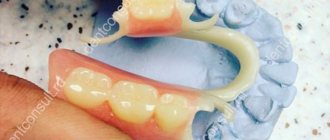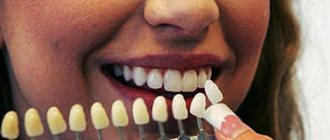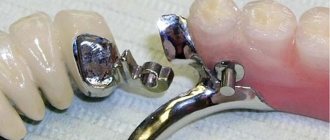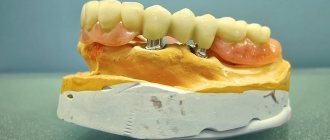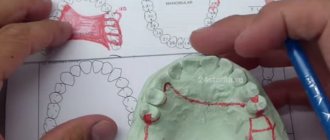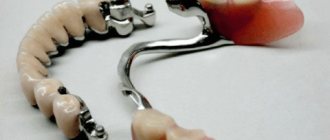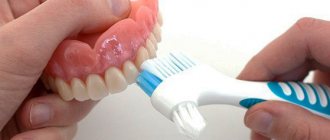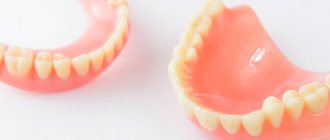One of the types of orthopedic structures is splinting prostheses, used for mobility of individual teeth or an entire row. The need for such prosthetics arises in case of periodontal diseases, when the dentogingival attachment is disrupted, and with the progression of the disease, the ligamentous apparatus is damaged and bone tissue atrophies.
Contact numbers of our clinics:
Belarusian (+7
or Leave a request and we will call you back
Leave feedback
What is a splinting clasp prosthesis?
A clasp-type splinting prosthesis is a type of prosthetic structure, the base of which has the shape of an arc and is made of metal. When put on, the product fits tightly to the gum and is attached to the inside of the supporting teeth. Special fastening elements (clasps) provide reliable fixation of movable units.
In addition to the aesthetic side, the prosthesis performs functional tasks - it redistributes the chewing load over the entire jaw. Metal structural elements have a splinting effect, which manifests itself in limiting the mobility of loosening units.
By permanently fixing the teeth in the desired position, they are prevented from becoming crooked or even falling out.
Best Alternatives
A less massive solution could be a special splinting thread - metal or fiberglass. It is glued to the moving teeth from the inside and combines them into one segment. But this is not a prosthesis, but simply a retainer. Those. You can’t place it if there are few teeth left and they are far apart. Bridges can be used as a splinting prosthesis with little mobility.
Complex on 4 OSSTEM implants with delayed loading - 140,000 rubles.
Complex implantation Osstem (South Korea) with delayed loading after 4-6 months.
Doctor's work guarantee - up to 5 years (under an agreement on the provision of medical services) Call now or order a call
Opening hours: 24 hours a day - seven days a week
However, dentists admit that the best solution is implantation. The implants are sterile; before their installation, the oral cavity is sanitized (all areas of inflammation are removed). Yes, in most cases you will have to “sacrifice” the remaining loose teeth, but this loss is offset by the following benefits:
- implants are fixed very securely and for life,
- You will be able to chew with the new dentures immediately,
- pain, inflammation, bleeding will disappear,
- the smile will become aesthetic,
- dentures will last a very long time (2 times longer than conventional ones).
Indications for installation
Installation of the prosthesis.
Dental splinting is mainly used to correct the following problems:
- the absence of three units in a row in the dentition, while one of the sides does not have an abutment tooth;
- incorrect position of teeth;
- absence of one unit in the dentition;
- bleeding gums;
- displacement of teeth with exposure of roots;
- the presence of gum pockets and signs of periodontal disease;
- bruxism, deep bite;
- other dental anomalies.
The primary task in diagnosing periodontal diseases is the installation of a bridge process in order to evenly redistribute the load on the supporting teeth. The progression of periodontitis provokes the loosening of units, which requires urgent measures to prevent their loss.
The clasp design firmly holds the teeth in the correct direction with the help of special fasteners and a metal arch.
Types of clasp dentures
Clasp structures are a solid frame made of metal (cobalt-chromium alloy), onto which a retaining arch, a base made of acrylic material and a base with artificial teeth are attached.
Supporting and retaining elements can be:
- solid;
- composite (metal elements soldered together);
- separate (wire elements subsequently soldered together).
In addition, clasp structures can be attached to the patient’s jaws in different ways. Such mounting options can be:
- metal clasps (or hooks);
- locks (attachments);
- telescopic system.
Let's try to evaluate the most important advantages and disadvantages of various types of fastening these removable dental plates.
Design Features
Splinting structures have a number of features:
- the base , made of plastic or a combined material, is distinguished by its reduced size, which facilitates rapid adaptation to a foreign body in the mouth and comfortable wearing;
- according to the method of installation, the products are removable and non-removable (the former are easily put on and removed by the patient independently, and the latter are fixed for a long time, subject to constant wear for 2-6 months);
- according to production technology, structures are either solid-cast or soldered (in the first case, a non-separable frame is used, the second option involves stage-by-stage production with subsequent assembly);
- the base part does not come into contact with the palate, which eliminates distortion of speech or taste sensations;
- splinting products prevent bone tissue atrophy; while chewing food, the load is redirected to the entire jaw;
- products are highly durable;
- the design helps restore the anatomy of the dental system.
Advantages
Positive aspects of clasp dentures:
- strong fixation – among removable structures they are the most reliable;
- convenient configuration – provide a more uniform distribution of the load on the soft tissue of the gums due to the presence of supporting teeth;
- comfortable to wear - a relatively small base does not cover the palate, does not distort taste, does not impair diction and does not rub soft tissues;
- possibility of installation without grinding healthy teeth;
- long service life - with proper care it can last up to 10 years.
On a note!
A clasp prosthesis, as well as its plate analogue, can lead to gradual atrophy of bone tissue, however, due to optimal redistribution of the load, it develops 2–3 times slower than with any other types of removable structures
.
Making a prosthesis
Manufacturing of a splinting clasp prosthesis.
To make an individual prosthesis that would meet all the requirements and perform its functions, you will need to visit the dentist’s office several times. Several stages go through until the finished product is received.
- Initial visit: the doctor examines the patient’s oral cavity to identify pathology, measures the dentition and prepares supporting elements. Based on a visual examination and diagnostic studies, the specialist outlines a treatment plan.
- In a laboratory setting, impressions are taken of the patient's jaws. This work is performed by a dental technician.
- Based on the impressions obtained, the specialist performs computer modeling of the prosthesis, and a model is cast from plaster and wax. The base and frame for artificial teeth are cast in the same way.
- During the first fitting, inconsistencies and other errors made during modeling are identified.
- Based on the fitted model, a clasp prosthesis is made. At the final stage, the product is sanded and polished.
The design production time is about 10 days.
When is it better to use clasp dentures?
Clasp dentures (from the German “clasp” - arch) are used in any situation when part of the teeth is lost. This method of dental restoration is considered one of the most reliable, aesthetic and comfortable.
Clasps always have a cast frame in the form of a thin arc onto which artificial teeth are attached. It is the metal base that makes the prosthesis as durable and elegant as possible, reducing its thickness and overall volume.
Recently, orthodontists often recommend that patients use plastic or nylon removable dentures. However, they are not used in all complex cases of dental pathology, unlike clasp plates. Thus, unlike a bridge prosthesis made of acrylic plastic, a clasp prosthesis is devoid of a massive bridge, which so often causes discomfort and difficulty in getting used to the prosthesis in patients.
In addition, the clasp prosthesis is reliable, strong and not as susceptible to various deformations and breaks as its nylon counterpart.
Installation
The process of installing a splinting clasp prosthesis is conventionally divided into several stages. The list of planned activities includes a plan of treatment procedures, which is drawn up after an initial examination by a doctor.
- After the initial examination, the patient is sent for an x-ray, and is also offered to undergo additional laboratory tests, which allow an accurate diagnosis to be made.
- The selected teeth as supporting elements are prepared. A minimal layer of enamel is removed.
- During the manufacturing process of the prosthesis, the patient is invited to 1-2 fittings in order to eliminate inaccuracies.
- The prosthetic treatment is completed with the fixation of the splinting product and the specialist’s recommendations regarding the care of the structure.
Once every six months it is necessary to undergo a preventive examination to check the integrity and correct fit of the splinting structure. If any problems arise with the denture (breakage, loose fit to the gum), you should make an appointment with a dentist as early as possible.
Reviews
Clasp splinting structures can solve the problem of preserving and strengthening loose teeth.
When choosing a prosthesis, you need to understand that such structures also help restore lost teeth.
Here's what patients who use splinted dentures say:
- With age, the teeth became very loose and their gradual loss began. I thought that I would have to say goodbye to all my teeth. I went to the clinic, where they installed a splinting clasp prosthesis. The result inspired me. In place of the missing teeth, artificial ones appeared and the real ones became smoother and almost no longer wobble.
- I have been suffering from periodontal disease for ten years now. I had five lower frontal teeth splinted two years ago. It took me a long time to get used to the prosthesis. The convenience is that it does not need to be removed at night, but only for hygiene purposes. The teeth are almost not loose.
- With age, there was a great deal of tooth loss. Three years ago I went to a dental clinic, where I was splinted with removable dentures with locks. It took two months to get used to them. Now I don't notice them. It's as if they were my family.
- A year ago I installed a clasp prosthesis and I really regret it. On the first day of use, my gums hurt badly, after which I felt for a long time that I had a large piece of metal in my mouth. Aching appeared in my front teeth. I went to the dentist, who said that this is normal. Some people take six months to get used to the design. Now I’m almost used to it, but sometimes I still feel discomfort.
- I have been suffering from periodontitis for a long time. Over the past two years, teeth have become loose and even fallen out. The dentist installed a splinting prosthesis. I was pleased with the result, because I had something to chew and the speech impediment that was due to the absence of several teeth disappeared.
- With age, some of my teeth have become loose. I installed the clasp design with effect. The prosthesis is very comfortable to use. Does not interfere with eating or talking.
- Several teeth were missing on the lower jaw, and some of the others were very mobile. Three years ago, I installed a splinting prosthesis, which helped restore missing teeth and strengthen loose ones. My teeth are no longer falling out - I’m very happy with the result.
Fastening methods and photos
Clasp dentures have different types of fastenings. The most popular are the following locking elements.
- Clasps - hook-shaped locks extend from both sides of the base, which are fixed to the supporting units. The chewing load is redirected to the supports. The strength of the structure is ensured by the manufacturing technology; the clasps are cast together with the frame. Products with clasp fastening are considered a budget option due to their relatively low price. The disadvantage of the prosthesis is that with an open smile and an emotional conversation, the hooks become noticeable to others.
Clasps
- Guzikova's paws - a design feature is the presence of an endless clasp located on the lingual surface of loose teeth. Products have also been developed with two endless clasps that extend from the vestibular and lingual sides.
Guzikova's paws
- Telescopic crowns are one of the innovative and complex prosthetic systems. The design consists of two parts: one is attached to a metal plate, the other is placed on support units. They are in close contact with each other. Installation of such a prosthesis requires minor grinding of the supporting teeth. The quality of prosthetics largely depends on the professionalism of the doctor.
Telescopic crowns
- Attachments – the fastening consists of micro-locks that are almost invisible in the mouth. They provide reliable fixation of the structure. The load is redirected to the supporting teeth. In dentistry, different types of attachments are used: rail, spherical, crossbar. The type of fastening on the prosthesis is determined by the orthodontist together with the dental technician.
Attachmen
Description
Structurally, such dentures are a metal arch, which is fixed on the inside of the jaw. This arch consists of several elements responsible for the reliable fixation of teeth, for example, clasps and claw-shaped processes. The attachment is made to the supporting teeth, for which they need to be “hidden” under the crowns, this will allow the entire chewing load to be distributed evenly between the teeth.
The effectiveness of treatment will largely depend on the timeliness of the patient’s application; the sooner he reports his problem, the better. Naturally, much also depends on age, condition of teeth, degree of problem and other factors.
Features of a splinting clasp denture for the upper and lower jaw
Prosthetics on the upper jaw are performed mainly with clasp dentures. This is due to the following qualities of the product:
- high strength;
- the palatal space does not close completely;
- during the period of adaptation, the gag reflex is not observed;
- the development of prosthetic stomatitis is excluded.
Splinting structures are recommended for restoring dentition in which one or more units are missing. If all teeth are missing, a decision is made to install implants (at least four). Prosthetics with splinting products on the upper jaw are performed in the presence of loose units, their anomalies, as well as for therapeutic purposes in case of periodontal diseases.
Products for the upper jaw are made from openwork casting. The main material for the arc is predominantly a medical alloy. The technique of installing a prosthesis is complex, so it is important that the doctor has the skills and knowledge to perform the job efficiently.
Prosthetics on the lower jaw are carried out faster and easier , therefore all types of clasp dentures are used to restore the dentition. The design is simpler; it lacks the palatal part. The load during chewing is redirected to the supporting teeth, which actually hold the clasp arch.
Telescopic fixation system
This fastening system is the most complex and modern. In this case, telescopic crowns are made of two parts in contact with each other. One part of the crown (lower, non-removable) is installed in the supporting teeth, and the other (upper, removable) is firmly fixed to the metal plate of the clasp.
When fastening, the upper part of the telescopic crowns fits tightly onto their lower part. Shrinkage of the fastening when installing a removable structure ensures reliability and strength of fixation. And although this type of fastening is not cheap, it serves reliably for a long time and only needs minor correction.
Unfortunately, for Russia this type of fastening is still new and is used infrequently. To work with these types of clasp fastenings, you need a highly qualified orthodontist. But in America and Europe, telescopic mounts are already common and familiar.
Features of care
Fastening of the clasp prosthesis (attachment).
Caring for clasp dentures involves performing the same measures as for other types of structures.
Basic rules of care include:
- for hygiene procedures (2 times a day), use a non-abrasive paste and a brush with medium-hard bristles;
- After each meal, use a mouthwash to remove small particles of food;
- clean dentures with a special solution once a day;
- undergo a preventive examination with a dentist at least once every six months in order to identify problems early;
- review your diet, reducing the consumption of sweets, soda, foods with a solid structure, the same applies to sticky and viscous foods.
Compliance with simple requirements extends the life of prosthetic structures, reduces the risk of developing dental diseases, and, importantly, minimizes the risk of prosthetic breakage.
Rules for caring for artificial teeth
In order for the splinting clasp device to serve for a long time and maintain its aesthetic appearance, it is important to properly care for it. You can minimize the risk of frequent breakdowns if you follow simple rules:
Clean the device twice a day with a brush and paste that does not contain large abrasive particles;- rinse your mouth after each meal with warm water or an antibacterial dental rinse;
- clean the system every evening with a special solution;
- Avoid eating too hard foods and never chew on foreign hard objects;
- Visit the dentist twice a year so that he can assess the condition of the prosthesis and correct its location in the oral cavity.
If your denture fails, you should not attempt to repair it yourself. The most reasonable decision in such a situation is to contact your doctor. He will examine the breakdown and, if it can be corrected, will transfer the device to a dental technician. If it turns out that the device needs to be replaced with a new one, he will take care of this issue.
Advantages and disadvantages
Before deciding to install a splinting clasp prosthesis, you should carefully familiarize yourself with the advantages and disadvantages of the design.
| Analysis of splinting clasp dentures | |
| pros | Minuses |
| High aesthetic qualities, skillful imitation of natural teeth. | The option of prosthetics cannot be called affordable. Even the most budget prosthesis will cost at least 40,000 rubles on a turnkey basis. |
| Does not irritate soft tissues of the oral cavity. | The presence of clasps reduces the aesthetic qualities of the splinting product. |
| Prevents bone tissue atrophy. | A prerequisite for this type of prosthetics is the presence of 4 teeth on each jaw, which are used as supports. |
| The installation technology of the structure is simple. | Locks on dentures can break, especially if recommendations regarding the consumption of foods with a solid structure are not followed. |
| Long period of wearing the product without loss of functionality. | |
| Possibility of installing a splinting structure in the presence of periodontitis. | |
| The clasp denture redistributes the load evenly throughout the jaw, which prevents wear of the supporting teeth. | |
| Removable structures can be used not only for medicinal purposes, but also to prevent tooth loosening. | |
| Wearing the splinting product is comfortable due to its small base. | |
| The period of adaptation (getting used to the prosthesis) is short in comparison with other types. | |
| Taste sensations and speech do not change while wearing a splinting product, which is explained by the absence of bridges covering the palate area. | |
Distinctive features of clasp splinting developments
If we compare a splinting prosthesis with a conventional clasp prosthesis, it is usually more convenient to use. This is explained by the fact that its basis is smaller. It also does not cover the palate and leaves the tongue free. This means that neither diction nor a person’s taste sensations change.
It is important that splinting clasp systems do not cause atrophic changes in the gums and bone tissues of the jaw. Therefore, when wearing them for a long time, the patient does not experience any significant discomfort.
Contraindications
This is what a clasp denture looks like in the mouth.
Splinting clasp dentures have a number of restrictions on installation. They mainly concern the following cases:
- pregnancy period;
- the presence of a negative reaction of the body to metal;
- mental disorders (in particular drug and alcohol addiction);
- cardiovascular diseases;
- during the rehabilitation period after undergoing radiation therapy;
- oncological diseases;
- problems with bone tissue;
- respiratory tract diseases.
Prosthetics are also not performed for dental problems:
- low level of oral hygiene;
- inflammation of the mucous membrane and dental tissues;
- shallow depth of the bottom of the mouth;
- atrophy of the alveolar processes;
- when diagnosing a deep bite, but without the possibility of using another treatment method;
- with pathology of the supporting units or their small height, which makes fixation of the prosthetic structure impossible.
What does a clasp prosthesis consist of, what materials are used in its manufacture?
A modern clasp prosthesis, made from high-quality materials, looks quite aesthetically pleasing. It consists of four parts.
- Frame (clasp). Durable, thin and light. It includes: a cast arch that evenly transfers the load to the jaw in places of missing teeth, slowing down the processes of bone resorption;
- mesh for attaching artificial teeth, allowing you to create a single structure;
- fasteners (clasps, beam structures, telescopic crowns, anchor and magnetic clamps) for rigid, elastic or hinged fastening on supports (healthy teeth, implants, crowns);
- splinting elements (according to indications - claw-shaped hooks, clasps, Elbrecht splints).
Materials for making a prosthesis
- Frame, fasteners. Using classical technology, the base of the structure is made of metal using modern casting methods. Depending on individual tolerance and other criteria, alloys of noble metals, cobalt-nickel-chrome with minor impurities, as well as titanium are used.
Currently, there are more modern materials - thermoplastic polymers, which are not inferior in strength to metal, but are more elastic and comfortable. The most famous are ACETAL or Dental D from QuattroTi.
- Base. It is made using classical technology - hot polymerization from acrylic, and in modern versions, like the frame, from thermopolymers.
- Teeth. Plastic, composites.
The choice in favor of one or another material is determined by the individual sensitivity, wishes and financial capabilities of the patient.
Price
The cost of prosthetics using a splinting clasp prosthesis varies in each individual case, which is explained by design parameters, type of locking elements and other factors.
Approximate prices for installing a prosthesis:
- product with 2-3 clasps – 50,000-53,000 rubles;
- product with “Bredent” locking mounts – from RUB 90,000;
- elimination of single-end defects with products on MK-1 attachments – from 108,000 rubles;
- elimination of a single-end defect with products made of a special alloy with attachments – from RUB 280,000.
The high cost of splinting structures is due to the high time required to produce the product and the high-tech manufacturing process.
Content:
- Pros and cons of splinting clasp devices
- Distinctive features of clasp splinting developments
- Indications for installation
- Contraindications
- Manufacturing
- Rules for caring for artificial teeth
The optimal solution for tooth decay and loss is implantation.
But not all dental patients can afford this option. It is inaccessible to some due to contraindications and health problems, to others due to its high cost. A good alternative to implants are splinting clasp dentures. They are metal frames on which artificial teeth and gums are placed. The peculiarity of structures of this type is that they not only restore the integrity of the dentition, but also prevent further loosening of the movable units. They are usually used for increased tooth wear, pathological deep bite, and periodontal diseases.
Manufacturing and installation process, stages of work
Preparation
The creation of a clasp prosthesis begins with the planning stage. The patient's oral cavity undergoes a thorough examination. Orthopantomography and CT scanning of the jaw will help to examine all its anatomical features and ongoing processes.
It is important to know:
- Causes of tooth loss. This will help protect the supporting crowns from caries, as well as periodontal and periodontal diseases.
- The degree of their mobility. If necessary, the frame is supplemented with hooks, tires and other fasteners.
- Presence of jaw atrophy. In advanced cases, clasp prosthetics is not recommended. Only implantation can help.
If any diseases are revealed during the examination, sanitation of the oral cavity is required before prosthetics. Professional hygienic cleaning is also recommended, which will reveal the natural color of the patient’s tooth enamel in order to correctly select acrylic, thermopolymers or composite materials.
Impressions
To work, it is necessary to obtain two-layer anatomical impressions, with the help of which working models are made and the degree of fit, load distribution, compression level and other important parameters of the functionality of the prosthesis are subsequently controlled. The impression is taken using an individual tray.
Working model
Using super plaster, two working models are created based on the impression. One of them is used in the process of planning and modeling the frame, as well as installing dental crowns - up to the complete production of a partial denture. And the second is needed to check the cast metal frame.
Subsequently, using the plaster model as a basis, an identical one is made in a dental laboratory, but from refractory ceramics. With its help, wax modeling of the frame is carried out, taking into account all clasps, branches, retention meshes, fastening processes, occlusal pads and other elements, and subsequent metal casting is also performed.
Frame formation
Making a refractory ceramic model on top of the primary one with a wax model of the frame allows you to create space for pouring metal in exact accordance with the frame drawings. Subsequently, in an induction furnace or using other technology and equipment, the metal is heated to the required temperature and poured into the mold.
After cooling, the surface is processed to remove mold residues and polished until an ideal fit to the working model is achieved, and then in the oral cavity during fitting.
Basic requirements for this:
- compliance with original drawings;
- absence of defects (sagging, cavities);
- ideal fit on the support and prosthetic bed;
- no problems when closing the dentition.
Formation of the base and installation of dental crowns
Artificial teeth are installed on a finished metal frame using a wax roller, and then the base of the clasp denture is modeled, taking into account the characteristics of the patient’s gums (size of interdental papillae, periodontal ridges).
Then, after checking the correctness of the created design by trying it on with the patient, the prosthesis is plastered and the wax is replaced with acrylic. The finished result must be aesthetic and correspond to the drawing conceived at the very beginning.
Checking the prosthesis for fit and installation
The finished prosthesis is tried on a model, and then the fit in the oral cavity is assessed. The result is considered ideal if the prosthesis is as similar as possible to the tissue in the patient’s oral cavity. It must be perfectly polished, match the color scheme of natural tooth enamel and periodontal tissues, fit accurately onto the support and prosthetic bed, and ensure ideal occlusion. After the final fitting, the finished product is polished and then secured in the patient’s mouth.
Consultation
The dentist at our clinic will definitely instruct the patient on how to care for the clasp denture in order to maximize its service life. Will answer any question and remind you of the need for professional hygienic cleaning of dentures. This will save artificial teeth for many years.
Clasp prosthesis: price in Moscow and regions
Clasp denture is the most popular type of denture for partial absence of teeth. You can read more about reviews of this type of prosthetics in the article: “Reviews of clasp prosthesis.” Now let's figure out how much a clasp prosthesis costs in clinics in 2021 (in economy class and mid-price clinics).
- Clasp prosthesis with clasps - the cost of a simple clasp prosthesis with clasp fixation in Moscow will be from 40,000 rubles, and in Russian regions the price will be from 35,000 rubles. The cost of a complex clasp prosthesis with clasp fixation (in the presence of a complex branched system of clasps), as well as a splinting clasp prosthesis in Moscow will be from 45,000 to 50,000 rubles.
- Clasp prosthesis on telescopic crowns - the cost of such a prosthesis starts from 75,000 rubles, and on average can be about 90,000 rubles. Typically, the required number of telescopic crowns is already included in this price, but some clinics may not include the cost of manufacturing metal caps in the cost of the prosthesis. This needs to be clarified during the consultation.
- Clasp prosthesis with attachments (micro-locks) - a prosthesis using inexpensive economy-class micro-locks will cost in Moscow - from 70,000 rubles, and for the regions from 65,000 rubles.
However, if prosthetics are performed using expensive micro-locks such as Bredent, the cost will be approximately another 20,000 rubles higher. It should be taken into account that the above prices already include the cost of the prosthesis itself, the cost of micro-locks, but does not include the cost of metal-ceramic crowns and preparation of teeth for prosthetics. The price for a one-sided clasp prosthesis will be about 50,000 rubles. This type of prosthesis is made for a unilateral defect in the dentition. This includes the cost of the prosthesis and micro-lock, but does not include metal-ceramic crowns.
Clasp dentures on a titanium frame –
All the above prices are typical for clasp dentures, the metal frame of which is made of cobalt-chromium alloy (CHS). We have already said that titanium is 2 times lighter than KHS, and also up to 5 times stronger. In addition, titanium has much greater tissue biocompatibility and a much lower risk of allergic reactions to metals. But prostheses with a titanium frame are much more expensive.
The cost of the simplest clasp prosthesis with clasp fixation (no more than 2 clasps) will be at least 50,000 rubles. In turn, the price for clasp prostheses made of titanium, which have a complex design, can range from 60,000 to 110,000 rubles. We hope that our article was useful to you!
Sources:
1. Personal experience as a dentist, 2. “Orthopedic dentistry. Textbook" (Trezubov V.N.), 3. National Library of Medicine (USA), 4. "Removable dentures: a textbook" (Mironova M.L.), 5. "Teeth restoration with clasp dentures (Fadeev R.A.) .
How clasp dentures are attached, their types, methods of fixation
Artificial structures are fixed using four main methods:
- adhesion. This is the name for the process of adhesion of two surfaces. In a clasp, it is acrylic or thermoplastic on one side, and the mucous membrane of the prosthetic bed on the other. This effect is enhanced by the presence of oral fluid;
- adhesion. One of the types of adhesion, when there is stronger adhesion between the molecules of the liquid and the surface during prosthetics than the intermolecular adhesion force of the oral fluid;
- anatomical retention. A number of structural features of the jaws make it possible to fix and hold the prosthetic structure in the oral cavity. These are the alveolar parts, maxillary cusps, interdental spaces, perigingival zone of the crowns;
- artificial fixation. It is carried out using manually created fastening elements. Among them, the following retainers are distinguished: Straight, located on the supporting teeth. Their task is to prevent the prosthesis from moving vertically.
- Indirect, located on the periphery of the structure. Also called kipmaiders. Prevents the structure from falling off. These include continuous clasps, occlusal overlays, and special extensions.
Let's consider all the options for artificial fixation in more detail.
On clasps
These are support-retaining clamps that have been used in prosthetics since 1926. Since their introduction, they have significantly expanded the possibilities of replacing lost teeth.
The structure of clasps is very diverse. They usually consist of two pointed arms and an occlusal pad, but different variations are possible depending on the purpose and purpose of fixation (two pads and an extended arm, multi-link splinting options, etc.).
Classification of clamps is carried out according to:
- principle of creation (bent, cast);
- material (plastic, metal);
- cross-sectional shape (round, ribbon, semicircular);
- rigidity of fixation (rigid, elastic, hinged);
- functionality (retaining, supporting, combined);
- degree of coverage of the dental crown (2-arms, 1-arms, flip-flop, double, multi-link);
- location of the shoulder (dental, alveolar, combined).
There are several requirements for clasps. They should not:
- harm aesthetics;
- injure periodontal tissues;
- interfere with the closure of the dentition;
- influence the physicochemical constancy of the environment.
They must also be able to be reactivated.
On locks (attachments)
Commonly used mechanical fasteners. Used for stabilization and retention. They consist of two parts - patrix and matrix. Functions – transmit the load through the axes of the teeth-supports into the periodontal tissue, participate in the redistribution of chewing pressure.
Pros - they fix and stabilize better than clasps. Higher hygiene and aesthetics, mechanical reliability and convenience. They allow you to create bridges of high quality and aesthetics when prosthetizing included defects in the smile area.
They are actively used in cases where increased demands are placed on dentures in terms of aesthetics, if there are secondary deformations of the dentition, atypical position and high crowns of supporting teeth.
On telescopic crowns
A fixation system consisting of two crowns - external (tooth-shaped) and internal (looks like a cap that is placed on prepared supporting tissues). Based on the manufacturing method, telescopic crowns are divided into stamped (simpler) and cast (high-quality), and based on the overlapping supports - closed, open and combined.
Plus - more reliable redistribution of load along the axis of the supports during operation. The downside is the need for significant preparation of the supporting teeth.
Beam system
The prosthesis is secured with this type of fixation by connecting its fixed and removable parts. The first is placed on the tops of crowns or prepared tissues of supporting teeth and has the form of a beam with a rounded cross-section. The second, removable, is located inside the prosthetic frame and is tightly fixed to the beam.
Pros – actively used for periodontal diseases. Recommended in the presence of partial edentia, single supporting symmetrical teeth, as well as a long-term defect in the lateral part of the jaw.
On anchors
This is a special type of fixation that works on the principle of a clothing button. The anchor consists of two fastening elements – a male and a matrix. Most often, the first is placed on the supporting tooth, and the second on the structure.
Pros: miniature size. Due to this, the anchors can be placed in areas of the base inaccessible to other clamps. Disadvantages - rapid wear during use (when removing/putting on).
